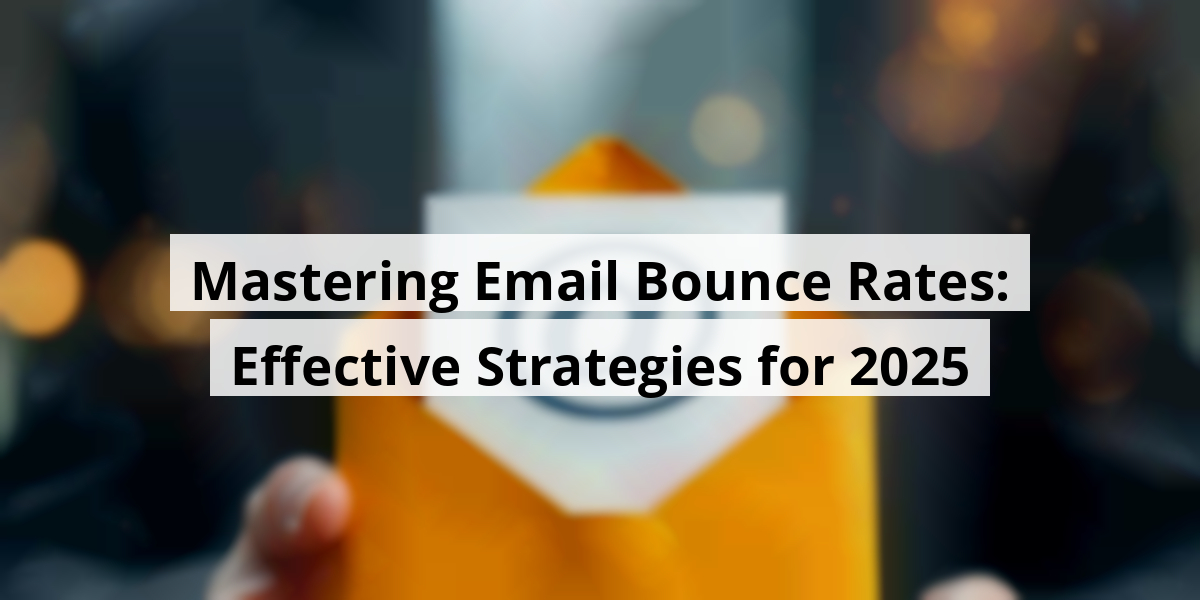 LIMITED SPOTS
All plans are 30% OFF for the first month! with the code WELCOME303
LIMITED SPOTS
All plans are 30% OFF for the first month! with the code WELCOME303

 LIMITED SPOTS
All plans are 30% OFF for the first month! with the code WELCOME303
LIMITED SPOTS
All plans are 30% OFF for the first month! with the code WELCOME303


Now we are going to talk about the pesky reasons your emails might just be hitting the digital dustbin, aka the dreaded bounce. We’ve all been there—typing out the perfect email, only to see it bounce back like a rubber ball. Let’s explore a few common culprits behind those high bounce rates, and what we can do to keep our emails flying straight into inboxes instead.
Imagine rolling into a party with a guest list full of no-shows. That’s your email list if it’s not properly cleaned up! Just because you ran it through a validation tool doesn’t mean it’s A-OK.
Here’s what might still be lurking:
Even seemingly clean contact lists can cause chaos—especially when sending out a bulk email. And as they say, every bounce is like a tiny wedge into your sender reputation.
According to a report, a whopping 94% of businesses think their data is less than perfect. So, if yours seems spotless, it might be time for a gut check!
Pro Tip: Make it a point to refresh your email lists every month or so. Toss out those non-active or cringe-worthy emails before they sink your ship.
Sending emails without proper authentication is like trying to sneak past a bouncer without an ID. If your SPF, DKIM, or DMARC records are wonky or non-existent, well, the mailbox gatekeepers won’t let you in!
Watch for these common blunders:
Heads up: Starting in May 2025, Microsoft is ramping up authentication checks. If your settings are off, be prepared for your emails to take a permanent vacation.
Even with the cleanest of lists and stellar authentication, if your sender reputation is as low as my luck at a casino, your emails will still hit the bounce wall.
Mailbox providers judge your reputation based on:
And if you suddenly jump from sending 200 to 5,000 emails, consider that a red flag waving like it’s at a parade. New domains especially face a trust deficit.
Fun Fact: 83% of the time emails bounce due to a lousy sender reputation. Ouch!
Even if you nail everything else, your email content can trip you up and lead to bounces or it landing in spam—talk about a stealth fail!
These smart spam filters are on high alert for any hint of dodgy content. Sometimes a seemingly innocent word can trigger alarms! Think about it:
If suddenly every ‘orange’ in emails gets flagged because of one bad apple, you’re left in the dust.
It’s not only about words, though—here’s what else to avoid:
And let’s not forget compliance! If your email is missing an address or has misleading subject lines, say goodbye to inbox placement.
Sending chaos! Imagine going from a steady stream of emails to suddenly flooding the inboxes. It’s like a toddler with a fire hose—mall cops will be all over you!
Providers are watching you! If they catch you sending a thousand emails when you were just cruising at 100, they’ll flag you as suspicious.
So, what might happen?
For new domains without a warm-up history, this kind of jump can be especially disastrous. They’ll just stop playing nice, and your carefully crafted emails could vanish into oblivion.
Now let's delve into the essentials of keeping emails from bouncing like a basketball in a gym full of kids. We're talking about practical tips that can save you from the frustrating "email not delivered" message—something that often feels like your inbox is playing hide and seek.


Each piece of your email puzzle, from domain setup to the sweet message inside, plays a crucial role in delivery. So, without further ado, let’s unpack a few tips to sharpen our email approach!
We’ve all had that awkward first date where we tried to impress too much—like suddenly sending 500 emails at once from a brand-new domain. Let’s not be that person!
Follow this warm-up routine to gradually build trust:
Stay on top of your warm-up. Trust issues can lead to disaster—nobody wants emails stuck in limbo.
Using a “valid” email is like thinking you can pull off a neon tracksuit at a formal event—just because it’s valid doesn’t mean it’s acceptable.
To keep things tidy:
If your emails bounce back with a “550 – Permanent Failure,” it might be time to check your SPF, DKIM, and DMARC settings—nobody wants a digital barricade!
To avoid this tech headache:
Most people trip over authentication without realizing it, so staying vigilant here is critical.
It's all about consistency. Sudden spikes in email volume might send your domain straight to the doghouse. Maintain a steady rhythm!
Simple guidelines for robust sending:
Even if everything checks out, poor content can pull the rug from underneath your email campaign. Treat your testing like a dress rehearsal before the grand performance.
To avoid mid-show catastrophes:
By following these tips, we can curtail bounce rates and ensure our emails end up exactly where we want them—right in the inbox, making connections rather than causing headaches.
Now we're going to talk about how to tackle that pesky issue of email bounce rates, because let’s face it, nobody wants their carefully crafted emails meeting a cruel digital graveyard. It's like sending out invitations to a party only to discover no one got them—awkward!

A high bounce rate smells like trouble, doesn’t it? It often means people aren’t trusting your domain. Picture this: maybe you sent out a batch of emails faster than a kid on a sugar rush, or you jumped the gun and skipped the warm-up ritual. It’s like sprinting on a cold morning without stretching—a recipe for disaster!
When bounces start piling up, it's like sending a love letter with a return address labeled “Do Not Trust.” Inbox providers take notice, and suddenly you’re wearing a digital “don’t let this guy in” sign. Your cold emails? Just sad little electronic orphans.
We’ve all had that moment when our great idea fizzles out because it didn’t land in the right inbox. That's where some handy tools come in. They can help simulate genuine conversations through platforms like Gmail and Outlook. This isn't about faking enthusiasm; it’s about winning over the algorithms that decide who’s in the inbox and who ends up in the spam folder.
Wouldn't it be grand to see those bounce rates plummet and your emails actually show up where they ought to?
Let’s take those first steps to warm up your email game!
| Email Strategy | What It Does | Impact on Bounce Rate |
|---|---|---|
| Warm-Up Email Strategy | Gradual increase in email sending | Decreases likelihood of bounces |
| Sender Authentication | Proves your identity | Boosts trust with inbox providers |
| Consistent Engagement | Sparks real conversations | Improves inbox placement |
To wrap it up, focus on building that sender reputation like it’s your investment in a cozy new apartment. Think about factors like:
With these strategies, we can transform those bounces into smooth landings, just like an expert pilot bringing a plane safely to a runway! Because who wouldn’t want their emails to strut their stuff right into the inbox?
Now we are going to talk about some important questions that we often hear regarding email marketing bounce rates. These bits of information can help us fine-tune our email strategies and keep things rolling smoothly.
Generally, we should aim for a bounce rate of less than 3%. If we're flirting with higher numbers, it's like a red flag at a bullfight. It may mean we need to tidy up our email list or double-check our sending practices.
Let’s gather around for a brief troubleshooting session! High bounce rates can often stem from:
A soft bounce can be seen like a minor hiccup—maybe the recipient's inbox is full. But a hard bounce is the email equivalent of a bad breakup—it’s over, and it’s usually due to an invalid address or a nonexistent domain. Trust us, hard bounces are the ones that really ding our sender reputation.
We’d recommend giving our lists a good ol’ scrub every 60 to 90 days. Especially when sending mass emails, keeping our list clean ensures we don’t see our bounce rate skyrocket like a kid on a sugar rush.
Absolutely! Email validation checks if an address is good to go, kind of like confirming dinner reservations. On the flip side, list cleaning is like spring cleaning for our contacts—out with the old inactive names, duplicates, and any spam traps that might be lurking about.
Oh, you bet! Just one bad campaign can spoil the bunch, affecting our sender reputation and making inbox placements as elusive as a cat at bath time. It’s best to approach every send with care.
Yes indeed! While warming up helps, the content and structure of our emails still matter. Even when we're feeling confident, we need to pay attention to avoid anything that might trigger spam filters quicker than a cat can knock over a glass of water.
To help keep things on an even keel, consider using tools like ZeroBounce or Verifalia for list validation. And don’t overlook your ESP’s analytics to keep tabs on those pesky bounce rates!

